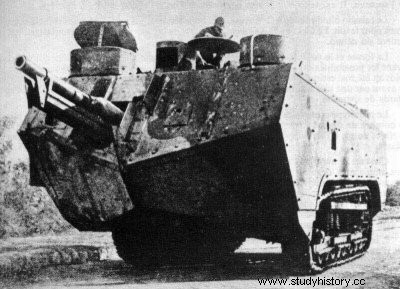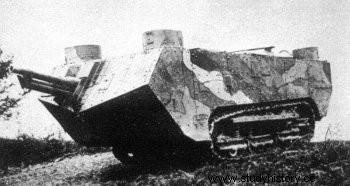General characteristics

Crew 8
Length 8.7m
Width 2.7m
Height 2.4m
Combat mass 22 tons
Armor and armament
Armor from 11 to 19 mm
Main armament 75 mm Saint Chamond L12CTR gun
Secondary armament 4 Hotchkiss 8 mm machine guns
Mobility
4-cylinder Panhard et Levassor
90 hp ( kW)
Road speed 12 km/h on road

The Saint Chamond rupture tank was the second tank produced by the French during the First World War. It was manufactured by FAMH, in Saint-Chamond. Born of the rivalry between FAMH and Schneider, despite four hundred copies produced, it proved to be rather unsuccessful, its large size limiting its evolutions in the field. The war ended however, before it was completely replaced by Renault FT-17s and British heavy tanks.
Development
Originally, the Saint Chamond and Schneider companies should have built the same tank, for which they each received an order for four hundred copies. In early 1916, while their joint prototype, Tractor A, was being finished in an army workshop, Private Pierre Lescure designed the fighting compartment, and Lieutenant Fouché had the suspension lengthened to improve handling. off-road.
However, Schneider's chief engineer, Eugène Brillié, rejected this first prototype. He chose a new design incorporating his invention, a tail allowing to cross the trenches with a much shorter body length, which made possible the creation of a lighter vehicle.
Brillé and Schneider refused to share Brillé's patented invention with Saint Chamond, and Saint Chamond refused to pay royalties to Schneider. From then on, the two companies worked on two very different vehicles, although each was derived from the A tractor. Schneider thus developed the Char Schneider CA1.
Saint Chamond used the relations at the Ministry of War of one of its technical directors, "Colonel" Émile Rimailho, to modify the specifications of the tank. Ministry specifications now called for the mounting of a 75 millimeter long-barreled gun, which the army had never requested. The result of this maneuver made the vehicle even more cumbersome, with an even longer and cantilevered combat compartment at the front. Despite everything, the first prototype of the Saint Chamond tank was presented in September 1916.
It should be noted that the designation (tractor A) of the original prototype common to Schneider and Saint Chamond was not due to any concern for concealment, but to the absence of an adequate term at the time for name it.
Description
Derived from tractor A, the Saint Chamond was an imposing vehicle, much larger than its rival. It was indeed longer by more than two meters, and heavier by eight tons.
However, despite its mass handicap, it was capable of a better top speed, thanks to its more powerful engine, and above all thanks to the use of an electric transmission which made possible much smoother evolutions. Unfortunately, this was only true on the road, because once in the mud of no man's land, the long nose tended to get stuck in the slightest accident of terrain. In addition, the transmission tended to heat up, and many tanks broke down before they even reached enemy lines.
Nevertheless at the end of the war when the front was moving it became useful to reach the artillery.
